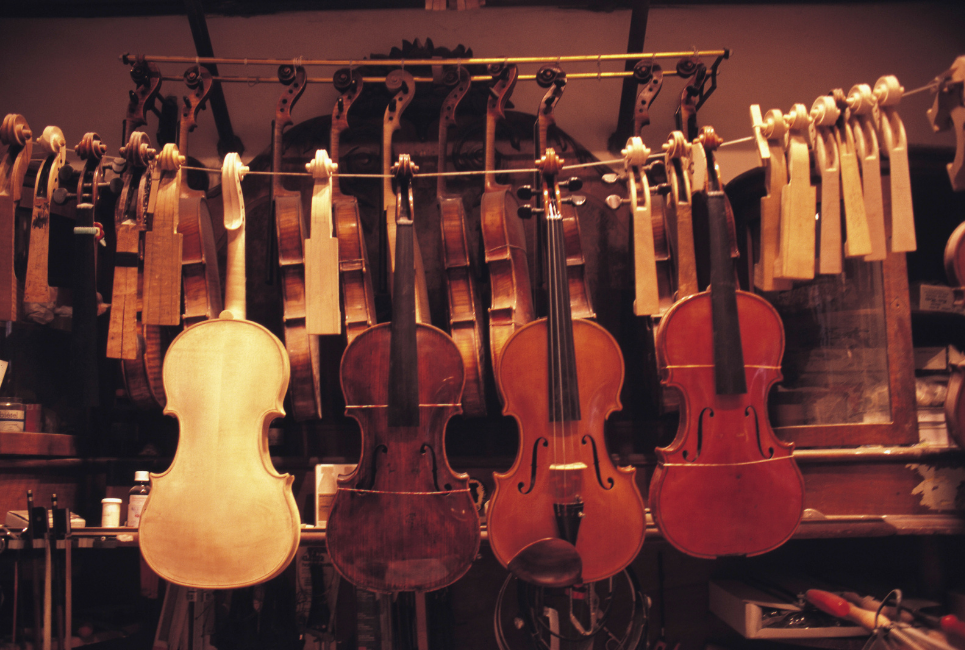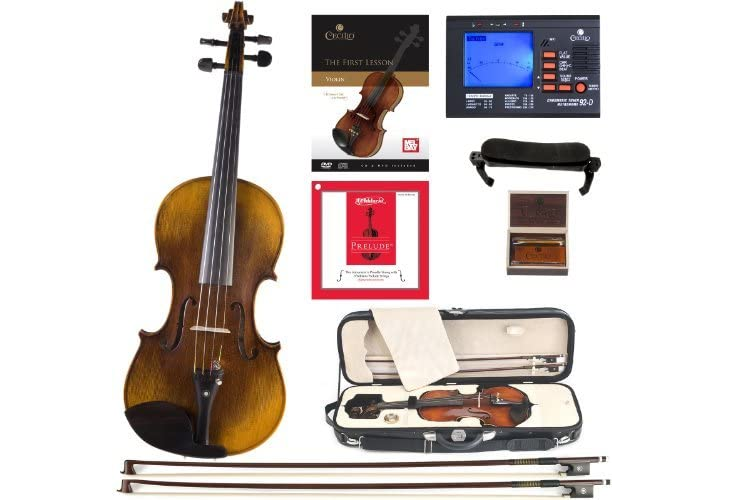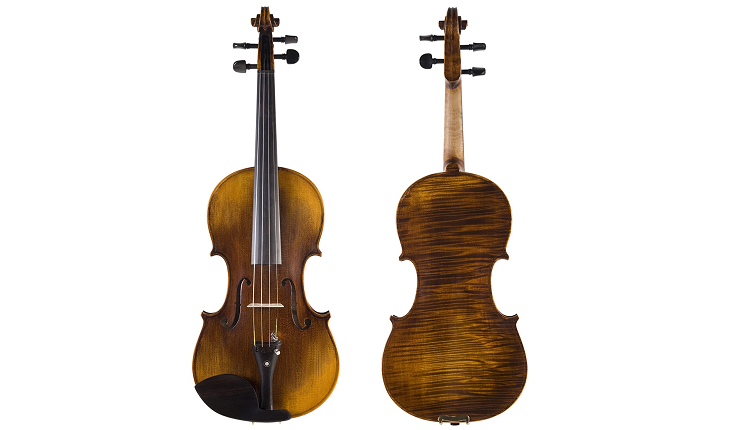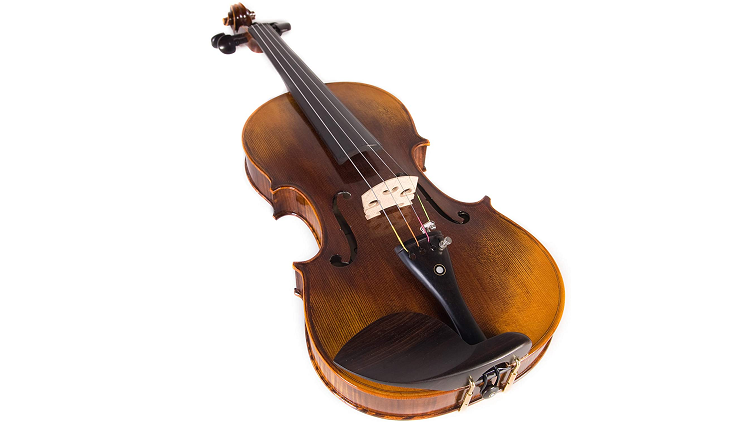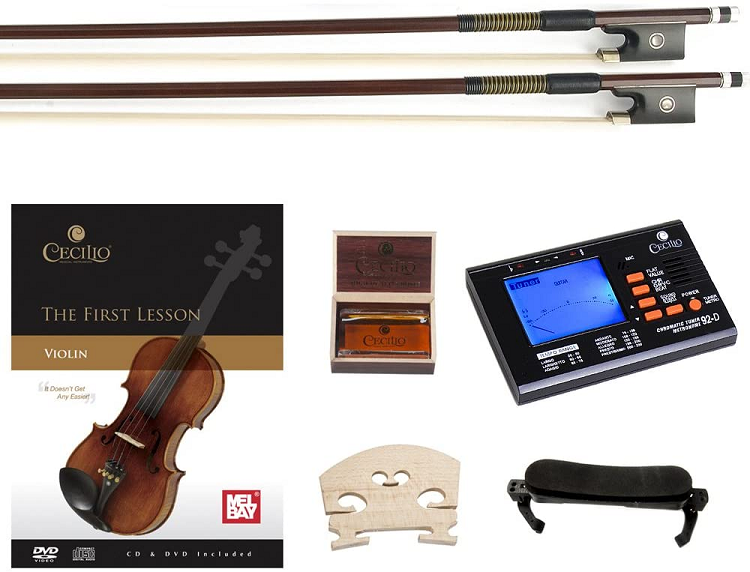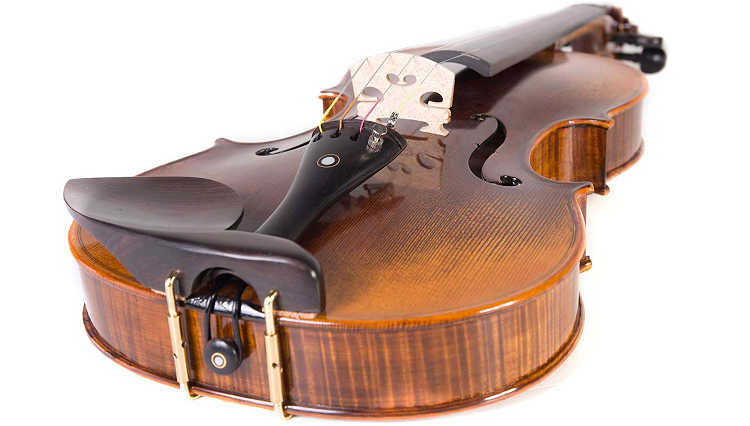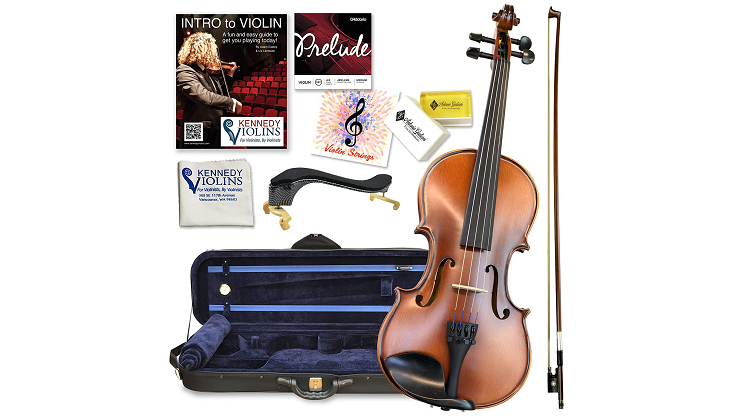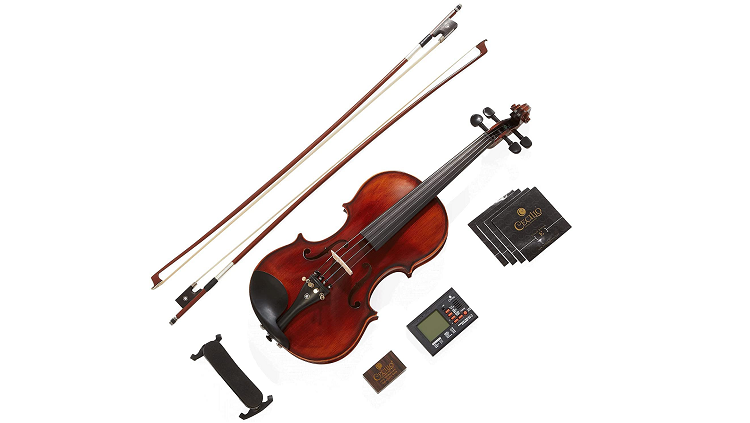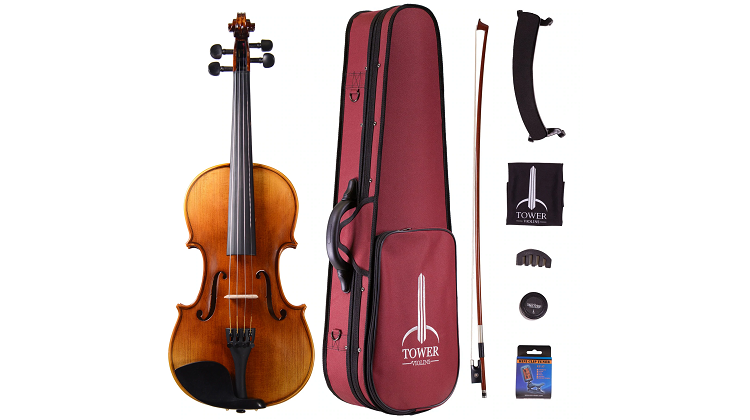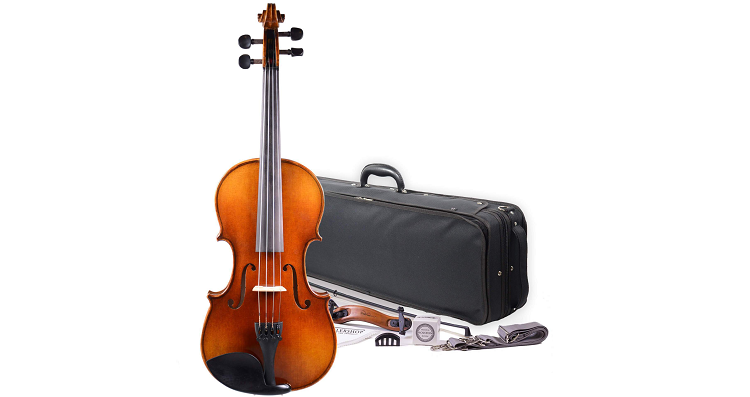- Best Fretted Violins Guide - May 31, 2022
- Best Yamaha Violins Brand Guide - April 13, 2022
- An Honest Mendini MV300 Review - March 31, 2022
It’s no secret that Cecilio doesn’t have the best reputation for their entry-level line. Still, the narrative changes when you focus on the CVN 500 and above. The CVN 600 is currently the best Cecilio violin you can get on Amazon, and it’s my favorite in their lineup.
While Cecilio markets this violin as an intermediate violin, I would say this is firmly a step-up instrument for those that purchased a cheaper Cecilio violin.
It’s also an excellent starter violin for someone who doesn’t want to upgrade within a year or two. I originally bought the CVN 300 as my first violin. Still, I wish I had given more consideration to this one because it’s not only beautiful but sounds significantly better.
Pros, Cons, and Bottomline
The CVN 600 combines several upgrades with a lovely tone to produce a violin worthy of multiple years of use. While this violin may not take a student through their college degree, it can stay with a student until they are nearing that level. Once you or your student start recording themselves for competitions or awards, they will need a new violin.
This can happen early in a musician’s career if they are exceptionally talented. More likely, it will happen later on in their music program. For those who have been learning since they were small, this will be when they enter high school or start applying for college if their degree is in music.
The CVN 600 is my first choice for Cecilio violins because of its mellow tone, aesthetics, and higher quality. While there are other choices, some with better quality materials, I would still recommend this violin. Especially if it keeps catching a new student’s eye.
Pros
- Hand-carved aged tonewoods
- 1 piece highly flamed maple back
- Hand rubbed oil varnish
- Ebony fingerboard and fitting
- Upgraded case
- Decent Strings
Cons
- A considerable jump in price from the CVN 500
- Accessories don’t match the quality of the instrument
- Will need to be adjusted by a luthier for brand new students adding to cost
- Better violins out there for only a little bit more
- Isn’t suitable for recording
What is a Step-Up Violin?
A step-up violin is a violin that helps bridge the gap between beginner and advanced. Beginning violins are great for students who are only taking private lessons. After a year or two, they will start looking to join ensembles or orchestras. In my experience, student instruments don’t produce a good enough tone to blend into an orchestra.
They are often bright and tinny instruments that sound alike. However, a step-up instrument will blend into an orchestra while still possessing a personality of its own. It will have a more complex tone with power and fullness.
So why not just buy a step-up instrument in the first place? Many people do, but these violins can be very expensive. Mine retails for 1250-1500, depending on the outfit. While you can find some as low as 600 dollars an outfit, if you are a serious student, you will want to spend at least $1,000.
Another reason why most people start on a beginner violin is that not everyone knows if they will want to play the violin long-term. This is especially true for children who may become bored after a few months and no longer be interested in learning.
Many people also rent their first violin, and those are overwhelming quality but inexpensive student violins. This reduces upfront cost but ultimately means you need to upgrade sooner than you would have.
Student vs Step-Up Violin
When comparing a student violin to a step-up or advanced violin, the most obvious upgrade will be the tonewoods that make the violin. Student instruments are typically made from unaged tonewoods sourced in China.
This type of wood is considered the lowest quality. While wood that has been aged 25 years or more and sourced from high altitude areas in Europe or the US is considered some of the best. In step-up or advancing instruments, I prefer European tonewoods that have been aged for at least 5 years. Still, Chinese sourced tonewoods that have been aged are also acceptable.
Some really inexpensive student instruments will feature maple fingerboards or “dyed hardwood,” which could mean any hardwood dyed black. Any violin worth owning will have an ebony fingerboard for durability. This is true regardless of violin or price. Even antique violins will typically have their fingerboards replaced with ebony at some point in their life.
For most violins, the fittings are standard ebony, including the pegs. The black suits most instrument varnishes and looks cohesive when in an orchestra. Still, fittings can vary; I often see boxwood as an alternative.
The tailpiece on student violins will have 4 fine tuners. In contrast, step-up and intermediate violins typically come with one on the E string. Depending on the tailpiece, this can vary and be changed by a luthier or yourself.
Student violins are typical ‘factory-made,’ meaning they are made by various people in a factory setting. Varnish is no different and typically applied via a machine.
Hand varnishing is reserved for more expensive instruments and means that one person carefully applied the multiple layers of varnish to produce a beautiful violin. For a step-up violin, hand varnish is wonderful but is not a reason to choose one violin over another.
The bridge on a step-up instrument is typical of higher quality, such as a French Despiau 3 Tree instead of a 1 tree. The setup is mainly done in a factory-like setting, and the violin will come with steel core strings.
As an advancing student, you will want synthetic strings on your step-up violin, and hand set up by a luthier is a must. The outfit will vary. Some step-up violins are more reminiscent of student violins and come with extras. Others will only come with the absolute essentials.
CVN600: The Good and The Bad
The CVN 600 surprised me in many ways while disappointing me in some. The violin’s body is made with a one-piece highly flamed maple back and solid spruce top. The tonewoods have been aged at least 7 years, giving this violin a much more mature and well-rounded sound than the lower-end violins in Cecilio’s line.
The hand-rubbed oil finish is dark amber with beautiful antiquing. I’m assuming the tonewoods are sourced from China, where Cecilio makes their instruments.
The fingerboard is the standard ebony with all ebony fittings. The tailpiece and pegs have a pearl inlay that looks very classy. The violin is pictured with only one fine tuner on the Amazon listing. Still, it definitely comes with four detachable fine tuners. The bridge is a standard Cecilio bridge, and it may or may not come notched and ready to play.
The setup on these instruments is the biggest disappointment. If it’s set up at all, it’s set up in a factory line. This violin deserves some extra attention to the placement and angle of the bridge and the strings. The strings included are basic D’Addario Prelude strings, but this violin would really suit some Thomastiks Dominants or Fiddlershop strings.
If you really wanted to get fancy, you could try some Helicores or Visions. If you are new to playing the violin or just don’t feel comfortable doing it yourself; taking it to a luthier for a complete setup will breathe some life into it. Don’t be surprised if they recommend a new bridge in addition to setting it up.
The outfit is bursting with the usual Cecilio accessories and oddities. The included case is a huge upgrade from the small triangle Cecilio case. It features two bow holders, a shoulder rest pocket, hydrometer, and temperature gauge, and a huge pocket for rosin, tuner, shoulder rests, and more. The two included bows are junk and not worthy of this violin.
Upgrading to a carbon fiber bow will help you produce a better tone. Cadenza, Glasser, or Fiddlershop are great options for various budgets.
The rest includes a tuner, rosin, shoulder rest, lesson book, and for some reason, an extra bridge. Overall it has everything a beginner would need to play their first scales or song. An advancing student will want to use their preferred accessories.
How Does She Sound?
For a violin under $500, the tone is the most surprising. There is no shrill tinniness reminiscent of student violins in the tone. Instead, you have a mellow and even tone. This violin feels and sounds a little empty out of the case, but there is power and promise behind it. Over time, the wood will age and settle, giving new complexity and maturity.
A better set of strings, as mentioned, will also bring some life into this violin. This violin can handle brighter strings like Visions with a deeper and mellow tone. Still, it can also handle darker strings like Obligatos. Giving it a wide range for players to find the exact tone they will want in their forever violin.
Since the tone doesn’t have a lot of complexity out of the case, it feels more suited for a student violin in that regard. This is why I wouldn’t recommend this to someone looking to upgrade their existing violin unless they have been renting for a month or two or purchased the CVN 100 or 200.
This will give a massive boost in the learning field over those violins. Instead, I would recommend this for a new player who wants a violin that will last a little bit longer than a cheaper student outfit. Players who need something more advanced will want to look at higher-end violins or check out their local music store stock.
Young players who are serious about their career as a violinist will need an upgrade as they move into high school or a year or two after. High school is a busy time for a growing musician. They will find themselves competing for various honors and awards within their school Orchestras and ensembles and through their state or even nationally.
College applications are just as rigorous. You will need an excellent violin to succeed in these areas, and this one just is not it. It won’t sound as good on recordings or project as well on stage.
For the average Orchestra student playing for fun instead of a career, this will suit them well through high school. Still, if serious ambitions arise, a new violin will be needed asap.
A Violin for High School and Beyond
If you wonder what kind of violin you should look at when you upgrade from the CVN 600, this can vary. If you are lucky, have a violin shop or music store that sells violins near you. Then I would suggest checking out their current stock to see if you like the sound and feel of anything.
The best violin pairings are when the violin is given a chance to choose the musician. If you are like me and live in a music store desert, your sites will quickly turn online. Thankfully, it’s 2022, and we have options for that!
My friends at Fiddlershop (they respond to my social media posts, so I’m gonna call them friends) are fantastic at finding the right violin for every customer, even as far as recording the violins so you can hear them. They have a huge lineup of violins, from beginner to professional. While they have their own budget, student and professional violins.
They also sell violins from makers like Scott Cao, Ming Jiang Zhu, Glasser, and Klaus Heffler. They even have a selection of used and fine antique violins. However, I try to ignore that tab, as everything is rather expensive, and I’m prone to falling in love. I’m fond of the Fiddlerman Soloist Violin for its complex tone and fantastic value for the price.
The tonewoods are hand-carved and dried for at least 12 years. The varnish is hand-rubbed, and the strings are hand chosen for this violin. The accessories include a complete outfit with a practice mute and tuner. Overall this violin rivals my Eastman VL305.
Speaking of Eastman, their advanced instruments are excellent. My VL305, while classified as a step-up violin by their standards, has been seen in numerous college Orchestras. One might say Eastman holds themselves to a very high standard regarding their instruments. It features European hand-carved tonewoods with a hand-applied varnish.
The tone is complex but a little bright; however, each violin at this price level is different. The outfit is very basic with a case and Cadenza bow, but it’s everything you need if you’ve been playing for a while. You can check out their construction method on their Facebook page!
DZ Strad and Kennedy Violins are two other known violin retailers. You can find a variety of violins at all price points. They are very similar in quality to Fiddlershop violins. DZ Strad makes some really interesting violins if you have the money to spend on them. Still, their student and intermediate models are just as beautiful for an affordable price.
I’m partial to the Maestro Old Spruce with Italian-aged tonewoods and quality accessories. You will love how this violin sounds with complexity and warmth.
Kennedy Violins is well known for selling its starter instruments on Amazon. Still, if you are searching for one of their higher-end violins, you’ll need to head over to their primary website.
The Zubak soloist is a gorgeous instrument and one of the most expensive on this list. With the hefty price tag, you will receive a violin made from solid carved aged European tonewoods.
The bridge is a custom French Aubert, and the fingerboard and fittings are 100% ebony. Unfortunately, it’s strung with Preludes, but this is an easy change since this instrument will arrive set up and ready to play out of the case. The outfit includes Piastro Gold Flex rosin, a CodaBow, and a deluxe case.
Alternatives to the CVN600
For some reason, the CVN600 doesn’t seem to strike your fancy. I’ve rounded up a few of my favorite alternatives. I tried to keep as close to the same price as possible; the CVN600 is an incredible value for the price.
However, for not much more, you can get other violins that will last longer. While I love this violin and have considered purchasing it as a backup, I know it’s not for everyone.
Top Pick – Antonio Guiliano Etude
The Antonio Guiliano Etude is an excellent starter violin from the Kennedy Violin store in Vancouver, Washington. Similar to Cecilio Kennedy, Violin manufactures its instruments in China. Unlike Cecilio, these instruments are set up in their store in Washington before being shipped. Every violin will come ready to play out of the case.
The Etude violin was made from tight-grained hand-carved solid spruce and maple tonewoods harvested from the high Himalayas. As far as Chinese tonewoods go, these are some of the best. The fingerboard and fittings are pure ebony, and the upgraded case includes a hydrometer. The bow is a standard brazilwood bow.
This one is of great quality and will serve a student for a good year before a replacement is needed. I find the tone of this violin to be similar to the tone of the CVN 600. It’s mellow and warm but a little empty at first. No doubt, in time, a personality will be revealed.
Budget Pick – MV500
Cecilio and Mendini are essentially the same company. The only difference is the varnish color and type of strings from instrument to instrument. The MV500 rivals the CVN600 in many ways while retaining its budget price tag.
While I wouldn’t put this instrument above the CVN600 in tone, I do consider it a viable alternative to the CVN600 with roughly the same amount of longevity for a considerable amount less. You forgo aged tonewoods and the upgraded case and strings with this price tag. Still, everything else is very similar to the CVN 600.
The tone is extremely similar, maybe a tad brighter on the upper register and emptier on the lower register, but overall incredibly pleasant and capable of taking a student through the basic and advanced levels. The same disclaimers as the CVN 600 apply for this violin, a complete setup, new strings, and a new bow.
Cecilio Alternative – Tower Strings Legend
The Tower Strings Legend is about 40 dollars more than the CVN600, and those 40 dollars contribute a lot to quality. Backed with professional violinist knowledge and the Fiddlershop guarantee, you will get a violin that is ready to play straight out of the case with quality accessories you won’t need to replace.
This violin features hand-carved and highly flamed tonewoods that have been aged at least 4 years. There are 100% ebony fittings and fingerboard, along with a hand-carved and hand-set-up bridge. The tailpiece is carbon composite which is a bit lighter than woods and has four built-in fine tuners, similar to a Whitnner tailpiece.
The strings are usually Preludes or Fiddlershop strings; other steel core sets may be chosen. Along with the violin, you will get a small but sturdy case, a good quality brazilwood bow (I still actively use mine sometimes), tower strings rosin (I also use this occasionally, it’s great backup rosin to my Kaplan dark), a practice mute, shoulder rest, tuner and polishing cloth.
Fancy Pick – Fiddlerman Artist Violin
If you have some extra money to spend but don’t want to spend 1200 to 1300 on a step-up violin. Then I have a slightly fancier student pick that may even take you through the top of a music program or high school. The Fiddlerman Artist Violin is made from hand carves solid tonewoods, aged at least seven years.
The varnish is hand applied, and the soundpost is made from European tonewoods. The fingerboard and fittings are ebony, with a carbon composite tailpiece with 4 built-in fine tuners.
The strings are custom picked for the violin, usually Kaplan Amo or Dominants. The outfit comes with an upgraded oblong case, a carbon fiber bow, wood violin shoulder rest (I have this, and it’s very nice), rosin, practice mute, and digital tuner.
FAQ
Answer: Definitely! I’m primarily self-taught with check-ins from a teacher here and there. I’ve found the hardest things to work on myself are correcting posture and the amount of bow I’m comfortable using.
There is a whole host of ways to learn things on your own with the internet, including software that can give you feedback. I currently use SmartMusic to practice with real-time feedback.
Answer: Yes, horsehair is very thick and coarse, durable enough to withstand the friction from the strings. Most of the time, this hair is humanely acquired during a horse’s normal hair routine or after a horse has already died from natural causes. Some bows are made with synthetic hair, but they don’t produce nearly as lovely a tone.
Answer: Technically speaking, yes, a violin can be a fiddle, and a fiddle can be a violin. It’s all in the type of music and the techniques you use when you play. Many fiddlers also prefer steel core strings because they are brighter and more responsive, which blends into twangyness of bluegrass country music.
Final Thoughts
The CVN600 is my favorite violin in the Cecilio warm-up. If a student preferred it over others, I would recommend it. It’s undoubtedly a worthy contender in the student violin lineup.
It will stay with a student until they are nearing the end of high school or their music program, but a serious student or someone who shows promise will need to upgrade much quicker. Overall the warm and mellow tone is a crowd-pleaser for myself and others. Suppose this violin doesn’t strike your fancy. In that case, there are several that will.
The Antonio Guiliani Etude and Tower Strings Legend will give the CVN600 a run for its money. While the MV500 is a great budget pick and the Fiddlerman Artist will serve a serious student for years.

